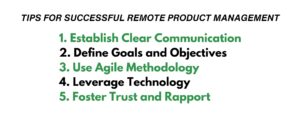Have you ever wondered if it’s possible to work remotely as a product manager or think of remote product management?
With the rise of remote work and the increasing demand for product managers, it’s natural to question whether the two can coexist. After all, product management is a role that requires collaboration, communication, and strategic planning, all of which seem challenging to achieve in a remote setting.
In today’s fast-paced world, remote work has become a buzzword. Many companies are now offering remote work options to their employees, including product managers.
But is it really possible to work remotely as a product manager?
In this blog, we will explore the answer to this question and provide insights into how remote product management can be done successfully.
Defining Remote Product Management
Remote product management refers to managing the entire product development process remotely. This includes everything from ideation to launch and post-launch support.
In a traditional setup, product managers work with teams in person, which allows for better collaboration and communication. In a remote setup, the team is distributed, and communication is predominantly digital.
Challenges of Remote Product Management
Remote product management has its fair share of challenges. The primary challenge is communication. When teams are not in the same location, communication can be challenging, leading to misinterpretation and misunderstandings. Additionally, remote product managers may face difficulty in keeping track of their team’s progress and staying on top of project timelines.
Another challenge is building trust and rapport with team members. In a remote setup, managers may not have the opportunity to interact with their team members face-to-face, leading to a lack of trust and personal connections.
Tips for Successful Remote Product Management

Despite the challenges, remote product management can be done successfully. Here are some tips for effective remote product management:
1. Establish Clear Communication Channels
Communication is key in remote product management. Establish clear communication channels such as instant messaging, video conferencing, and email to ensure that everyone is on the same page. Ensure that communication is frequent and that team members are responsive.
2. Define Goals and Objectives
Define clear goals and objectives for the product and communicate them to the team. This ensures that everyone is aligned on the product’s vision and what needs to be achieved.
3. Use Agile Methodology
Agile methodology is ideal for remote product management. It enables product managers to track progress in real-time and make necessary adjustments quickly.
4. Leverage Technology
There are several collaboration tools available that can facilitate remote product management. Utilize tools such as Asana, Jira, and Trello to manage projects and track progress.
5. Foster Trust and Rapport
It is crucial to foster trust and rapport with team members in a remote setup. Schedule regular team-building activities and informal check-ins to build personal connections and maintain a positive team culture.
Real-Time Examples of Successful Remote Product Management companies
Several companies have successfully transitioned to remote product management. One such example is Basecamp, a project management software company. Basecamp’s entire team works remotely, and they have been doing so for several years. The company uses video conferencing, instant messaging, and email to communicate and manage projects.
Another example is Buffer, a social media management tool. The company has a distributed team across different time zones, and they use tools such as Asana, Zoom, and Slack to manage projects and communicate.
Remote work is definitely possible for product managers. With the right tools, strategies, and mindset, remote product managers can be just as successful as their in-office counterparts. However, it’s important to also acknowledge the challenges and work to overcome them.






